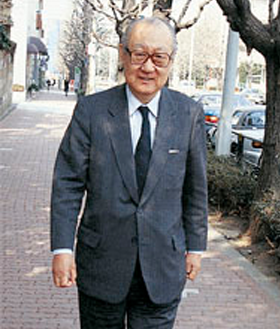heading
1994: Takeshi Kubo, Japan
Dr. Takeshi Kubo takes a walk along a suburban street in Tokyo, close to where he lives. The sidewalk is paved with reddish bricks made from dried wastewater sludge, fired in huge kilns. This very hard and resistant material is being used more and more in Japan as a foundation for buildings, sidewalks, paths and roads.

A small example perhaps, and yet a spectacular one, of the technical solutions that have grown out of Japan’s efforts in the area of wastewater treatment and sludge disposal.
How can a sewerage system for 12 million people best be organised? Dr. Kubo devoted almost half a century to answering that question, beginning in the early 1960s as the guiding hand in the planning of wastewater treatment facilities in Japan. In 1994 – the year he was awarded the Stockholm Water Prize – he rounded off a long career, at the age of 74, with the top position of General Director of the Research Institute for Wastewater Management.
As recently as the early 1970s, the rivers of Tokyo were white with foam and fetid with untreated wastewater, from both households and factories. This was the downside of Japan’s rapid process of industrialization and urbanisation.
“Things look very different today. We have tough water quality standards which industry has to comply with, and almost the whole of Tokyo is linked up to the city’s wastewater treatment plants. ”
In 1994, 93 per cent of the inner city was served by Tokyo’s 18 wastewater works, and there were almost 22,000 kilometres of pipes below the streets of the capital. By then, the outlying suburbs had a double-piped network to separate surface run-off and wastewater. And the citizens of Tokyo have Kubo to thank for most of these improvements.
Several waterways, long given up for dead, have been resuscitated by a supply of treated wastewater. One of them is the 350-year-old Tamagawa Canal from the Edo dynasty, now revived and full of thriving carp. Another example is the city’s pocket parks, whose beauty is greatly enhanced by tiny waterways fed by recycled wastewater.
But Takeshi Kubo’s interests have stretched far beyond the horizons of Tokyo and Japan. One of his contributions has been to get many Asian water professionals involved in cooperation with Western organisations, ensuring an exchange of knowledge across international borders. In the West he collaborated with Britain, the United States and Germany, in the East with Asian and Pacific nations as chair of the Asia/Pacific Rim Steering Committee of the Water Environment Federation. Kubo even managed to bring China and Taiwan together to tackle the important issues of wastewater treatment and clean water, and to do so with a holistic approach.
“It is essential to be able to control the whole catchment area of a river system, including the use of soils,” comments Dr. Kubo. “Whatever chemicals or fertilisers you use to increase yields in agriculture, sooner or later they will end up in a river. There is no way you can deal with land and water in isolation from each other.”
Since 1993, Dr. Kubo has been officially retired, but he nonetheless has found time on occasion to meet friends and colleagues at various international conferences, including the annual Water Environment Federation conference, the 3rd World Water Forum, and the Stockholm Water Symposium. For the 3rd World Water Forum, in fact, he prepared a special Japanese-language edition of the summary conclusions from the 10th Stockholm Water Symposium.
One highlight in recent years for Dr. Kubo was when he and fellow Hokkaido University alum Takashi Asano — the 2001 Stockholm Water Prize Laureate — were honoured on May 2004 at the university’s opening of a permanent Prize exhibit honouring the accomplishments of two of its distinguished graduates.